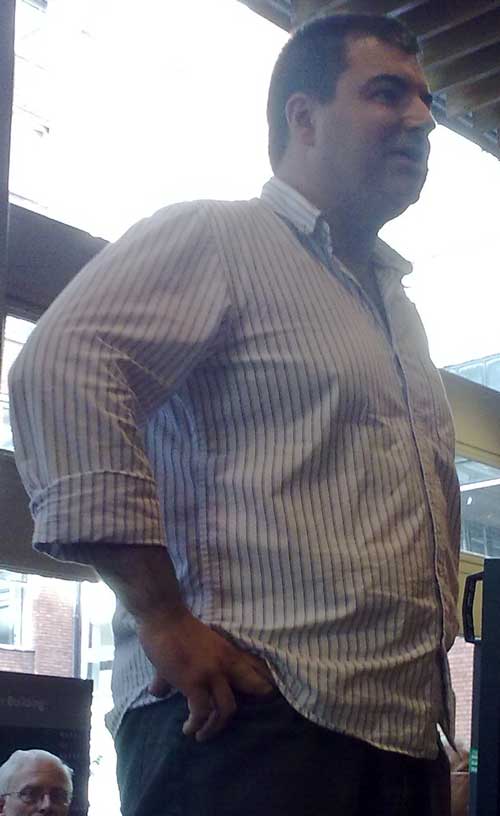.
Konstantin Novoselov

Konstantin Sergeevich Novoselov (Russian: Константи́н Серге́евич Новосёлов; born 23 August 1974) is a Russo-British physicist, most notably known for his works on graphene together with Andre Geim, which earned them the Nobel Prize in Physics in 2010.[1] Novoselov is currently a member of the mesoscopic research group at the University of Manchester as a Royal Society University Research Fellow.[2][3]
Early life
Konstantin Novoselov was born in Nizhny Tagil, Russia, in 1974 in a Russian family.[4] He received a Diploma from the Moscow Institute of Physics and Technology, and undertook his PhD studies at the University of Nijmegen in the Netherlands before moving to the University of Manchester in the United Kingdom with his doctoral advisor Andre Geim in 2001. He now holds both Russian and British citizenship.[5]
Career
Novoselov has published more than 60 peer-reviewed research papers, on topics like mesoscopic superconductivity (Hall magnetometry),[6] sub-atomic movements of magnetic domain walls,[7] the invention of gecko tape,[8] and graphene.[9]
Awards
* 2008 Europhysics Prize, "for discovering and isolating a single free-standing atomic layer of carbon (graphene) and elucidating its remarkable electronic properties."[10]
* 2010 Nobel Prize in Physics, jointly with Andre Geim, "for groundbreaking experiments regarding the two-dimensional material graphene."[1] Novoselov was the youngest Nobel laureate in physics since Brian Josephson in 1973, and in any field since Rigoberta Menchú (Peace) in 1992.
References
1. ^ a b "Announcement of the 2010 Nobel Prize in Physics". The Nobel Foundation. 5 October 2010. http://nobelprize.org/nobel_prizes/physics/laureates/2010/announcement.html. Retrieved 2010-10-05.
2. ^ fellow "Konstantin Novoselov". The Royal Society. http://royalsociety.org/News_WF.aspx?pageid=4294973256&terms=research+fellow&fragment=&SearchType=&terms=research fellow. Retrieved 2010-10-05.
3. ^ "Dr. Kostya Novoselov". University of Manchester, Mesoscopic Research Group. http://onnes.ph.man.ac.uk/nano/People/KostyaNovoselov/KostyaNovoselov.html. Retrieved 2010-10-05.
4. ^ "Physics Nobel Honors Work on Ultra-Thin Carbon Film", New York Times, 5 October 2010, http://www.nytimes.com/2010/10/06/science/06nobel.html?src=me .
5. ^ "Graphene pioneers bag Nobel prize", Physics World, 5 October 2010, http://physicsworld.com/cws/article/news/43939 .
6. ^ A. K. Geim et al. (2000). "Non-Quantized Penetration of Magnetic Field in the Vortex State of Superconductors". Nature 406.
7. ^ K. S. et al. (2003). "Subatomic Movements of a Domain Wall in the Peierls Potential". Nature 426: 812–816. doi:10.1038/nature02180.
8. ^ A. K. Geim et al. (2003). "Microfabricated Adhesive Mimicking Gecko Foot-Hair". Nature Materials 2: 461–463. doi:10.1038/nmat917.
9. ^ A. K. Geim, K. S. Novoselov (2007). "The Rise of Graphene". Nature Materials 6: 183–191. doi:10.1038/nmat1849.
10. ^ "Waters, Darren (2008) Nano switch hints at future chips". BBC News. http://news.bbc.co.uk/1/hi/technology/7352464.stm. Retrieved 2010-10-05.
Retrieved from "http://en.wikipedia.org/"
All text is available under the terms of the GNU Free Documentation License

